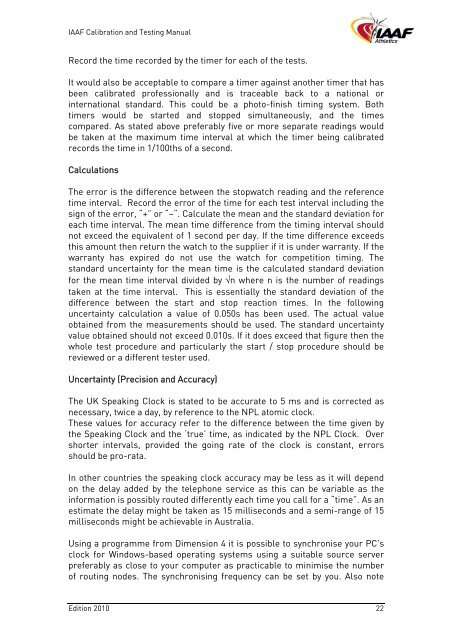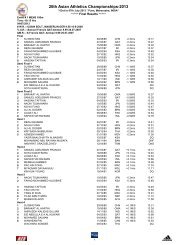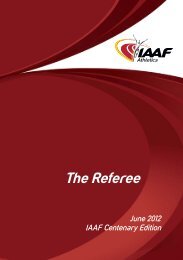IAAF Calibration and Testing Manual - Asian Athletics Association
IAAF Calibration and Testing Manual - Asian Athletics Association
IAAF Calibration and Testing Manual - Asian Athletics Association
You also want an ePaper? Increase the reach of your titles
YUMPU automatically turns print PDFs into web optimized ePapers that Google loves.
<strong>IAAF</strong> <strong>Calibration</strong> <strong>and</strong> <strong>Testing</strong> <strong>Manual</strong><br />
Record the time recorded by the timer for each of the tests.<br />
It would also be acceptable to compare a timer against another timer that has<br />
been calibrated professionally <strong>and</strong> is traceable back to a national or<br />
international st<strong>and</strong>ard. This could be a photo-finish timing system. Both<br />
timers would be started <strong>and</strong> stopped simultaneously, <strong>and</strong> the times<br />
compared. As stated above preferably five or more separate readings would<br />
be taken at the maximum time interval at which the timer being calibrated<br />
records the time in 1/100ths of a second.<br />
Calculations<br />
The error is the difference between the stopwatch reading <strong>and</strong> the reference<br />
time interval. Record the error of the time for each test interval including the<br />
sign of the error, “+” or “–“. Calculate the mean <strong>and</strong> the st<strong>and</strong>ard deviation for<br />
each time interval. The mean time difference from the timing interval should<br />
not exceed the equivalent of 1 second per day. If the time difference exceeds<br />
this amount then return the watch to the supplier if it is under warranty. If the<br />
warranty has expired do not use the watch for competition timing. The<br />
st<strong>and</strong>ard uncertainty for the mean time is the calculated st<strong>and</strong>ard deviation<br />
for the mean time interval divided by √n where n is the number of readings<br />
taken at the time interval. This is essentially the st<strong>and</strong>ard deviation of the<br />
difference between the start <strong>and</strong> stop reaction times. In the following<br />
uncertainty calculation a value of 0.050s has been used. The actual value<br />
obtained from the measurements should be used. The st<strong>and</strong>ard uncertainty<br />
value obtained should not exceed 0.010s. If it does exceed that figure then the<br />
whole test procedure <strong>and</strong> particularly the start / stop procedure should be<br />
reviewed or a different tester used.<br />
Uncertainty (Precision <strong>and</strong> Accuracy)<br />
The UK Speaking Clock is stated to be accurate to 5 ms <strong>and</strong> is corrected as<br />
necessary, twice a day, by reference to the NPL atomic clock.<br />
These values for accuracy refer to the difference between the time given by<br />
the Speaking Clock <strong>and</strong> the ‘true’ time, as indicated by the NPL Clock. Over<br />
shorter intervals, provided the going rate of the clock is constant, errors<br />
should be pro-rata.<br />
In other countries the speaking clock accuracy may be less as it will depend<br />
on the delay added by the telephone service as this can be variable as the<br />
information is possibly routed differently each time you call for a “time”. As an<br />
estimate the delay might be taken as 15 milliseconds <strong>and</strong> a semi-range of 15<br />
milliseconds might be achievable in Australia.<br />
Using a programme from Dimension 4 it is possible to synchronise your PC’s<br />
clock for Windows-based operating systems using a suitable source server<br />
preferably as close to your computer as practicable to minimise the number<br />
of routing nodes. The synchronising frequency can be set by you. Also note<br />
Edition 2010 22






